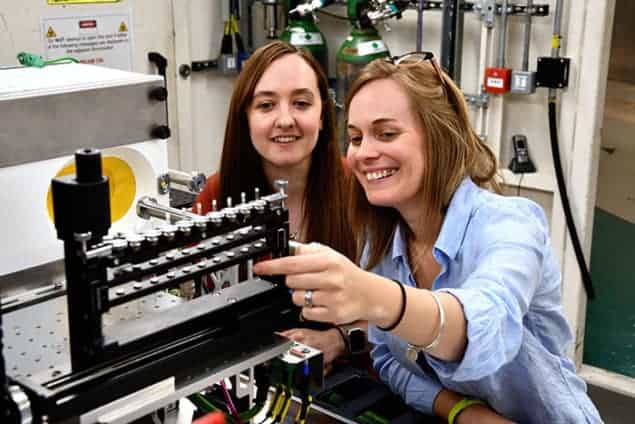
The longest-running synchrotron experiment has reached 1000 days. The experiment has been taking place at the Long Duration Experimental (LDE) facility at the UK synchrotron Diamond Light Source. Led by Claire Corkhill from the University of Sheffield, the experiment investigates the hydration of cement used to store nuclear waste.
The only resource of its kind in the world, the LDE facility allows scientists to test complex materials under a range of conditions over long periods of time, and then regularly characterize the material with synchrotron X-ray powder diffraction. The cement experiment was the first to be set up at LDE and is still running 1000 days on, making it the longest-running experiment to take place at a synchrotron.
More and more cement
Cement (also known as cement paste) is a mixture of silicates and oxides that, after reacting with water, forms a hard grey solid. Special types of cement are used to encapsulate some radioactive waste before storage, such as that arising from reprocessing spent fuel rods or from decommissioning nuclear facilities. It is therefore very important to understand how different types of cement behave over long periods of time. “The cement is being used to safely lock away the radioactive elements in nuclear waste for timescales of more than 10,000 years,” explains Corkhill, “so it is extremely important that we can accurately predict the properties of these materials in the future.”
This also applies to designing future waste storage. The nuclear industry’s current plan is to create a giant hole 500 m to 1 km deep and lined with different layers of cement, which will contain a series of isolated vaults for intermediate- to high-activity-level waste. Once each vault is packed full of the encapsulated waste, it will be closed and backfilled with even more cement. High-level waste is more of a challenge due to the extreme radiation fields, but will involve more cement.
Common but tricky
Although a common material, Corkhill explains that cement is tricky. The combination of water and powder forms some amorphous materials that are difficult to analyse. Because cement only stops reacting once the water added to it has run out, it can continue to transform for long timescales – indeed some of the eight nuclear-waste cement samples running at LDE are still changing. This is obviously a problem for underground storage where groundwater is likely to be present at some point over the several-thousand-year storage period.
At the moment, the team’s samples are in a “straightforward” environment – no additional water is present and they are running at room temperature and pressure. But the data collected once a week by the beamline scientists have allowed the researchers to build a geochemical model that can predict the cement phases in 1000 years. The more promising, stable cement will then be investigated further during another long-term experiment incorporating groundwater. Corkhill also hopes to encapsulate enriched uranium within cement and record the damage caused by the radioactivity from the inside out.
Successful collaboration
LDE senior support scientist Sarah Day and Corkhill both attribute some of the experiment’s success to the collaboration between academic users and beamline scientists at Diamond. “Being able to run experiments over 1,000 days is a great testament to how well we’ve engaged with our user community, enabling them to use synchrotron light to probe the frontiers of science,” explains Day.
Diamond scientists plan to build five more beamlines by 2020 and have recently demonstrated a proof-of-concept upgrade to the machine, which if delivered would provide light that is 10 times brighter to each beamline. But in the meantime there are no plans to end the cement experiment and it will likely continue breaking records until the materials are no longer changing or another experiment needs the space.



